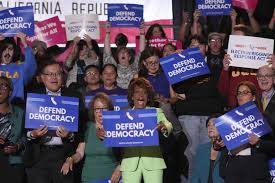
The rise of Donald Trump to the presidency, coupled with Republican control of Congress and the Senate, dealt a significant blow to California — a state that has long stood as a progressive counterweight to Washington. Trump has made little effort to hide his contempt for California’s Democratic leadership, frequently mocking Governor Gavin Newsom and other prominent figures like Representative Karen Bass.
Soon after taking office, the Trump administration began ramping up immigration raids in cities like Los Angeles, with federal agents operating openly and with little resistance. These actions were widely interpreted as political retaliation — a message sent loud and clear.
But the tide could soon shift. With the 2026 midterms approaching, the fragile Republican grip on Congress is at risk. Trump's unpopular policies have stirred unrest among voters, and Republicans are working hard to retain their advantage.
In a bold political move, Trump recently encouraged Texas Governor Greg Abbott to redraw congressional maps to favor Republicans and potentially gain five new seats. The message is clear: this is a power struggle, and Trump is trying to secure dominance in Congress before the next election cycle.
Governor Newsom wasn’t shy in responding: “If they go down that path, California will too — but with very different outcomes.” The implication? California could redraw its districts in favor of Democrats, potentially tipping the balance of power in Congress.
On Friday, Newsom unveiled a proposal to temporarily alter California’s redistricting system. It’s now set to be debated in Sacramento and could go before voters in a special election this November.
Why Redistricting Matters
Redistricting is the process of redrawing political boundaries — lines that define who votes for which representatives. These lines influence everything from local city councils to congressional seats in Washington, D.C.
What’s happening now is a national battle over congressional maps, which dictate who represents you in the U.S. House of Representatives. Though cities and counties manage their own redistricting processes, the current spotlight is solely on federal districts.
In theory, redistricting ensures fair representation. In practice, it’s often manipulated — a tactic known as gerrymandering — to favor one party or suppress the influence of certain communities.
How Redistricting Works — and How California Is Different
Each state controls how its congressional districts are drawn. In states like Texas, that power rests with lawmakers — a system vulnerable to political manipulation.
That’s why gerrymandering remains a persistent issue: while federal law prohibits racial discrimination in redistricting, it largely allows partisan gerrymandering to go unchecked. Most oversight happens at the state level.
California, however, took a different path in 2008. Voters passed a law that handed redistricting power to an independent citizens’ commission, made up of ordinary residents — not politicians. The commission must be politically balanced, including Democrats, Republicans, and unaffiliated voters, to limit partisanship.
What Newsom's Proposal Would Change
If approved, Newsom’s plan would temporarily suspend the independent commission’s authority — just for congressional districts, and only for one redistricting cycle.
State lawmakers would take over the process and redraw the congressional map for the 2026, 2028, and 2030 elections. After the 2030 census, control would return to the independent commission as scheduled.
This proposal marks a major departure from California’s established approach — and it would only go into effect if another state, like Texas, moves forward with mid-cycle redistricting first.
The Road Ahead: What Happens Next?
For the plan to move forward, several steps must happen quickly:
-
Legislative Approval: The California State Assembly and Senate must approve the proposal by August 22, with a two-thirds majority in each chamber. Lawmakers return from recess on August 18, leaving them a narrow window to act.
-
Special Election: If the Legislature signs off, voters will decide the measure in a special statewide election on November 4.
-
Other States’ Moves: California’s plan only takes effect if another state enacts mid-cycle redistricting first. If that happens, the new California map will apply to congressional elections in 2026, 2028, and 2030.
-
Legal Challenges: The plan could face court challenges that delay or block implementation before next year’s elections.
How You Can Get Involved
The fate of California’s redistricting proposal rests with state lawmakers and ultimately, with voters. If you want to weigh in:
-
Contact your state Assembly member and state senator to share your opinion.
-
You can look up your representatives here by entering your address.
The battle over redistricting is not just about maps — it’s about who has a voice in American democracy, and who gets to shape its future.

 Parriva's Team
Parriva's Team
SB 9-The Californis Home Act
Boyle Heights: Where do I Park?
IMMIGRATION
Immigration Detention Centers, Private Profits, and the Moral Test Facing Los Angeles Power Brokers
BUSINESS
Google Pomelli: The AI Marketing Tool That Could Change Small Business Branding
TikTok Is Giving Small Businesses a New Advantage — And Latino Entrepreneurs Could Benefit the Most
Gen Z Consumer Trends 2026: The Generation Reshaping Marketing and Spending
Why Your Social Media Strategy 2025 Is Already Outdated — And How to Fix It